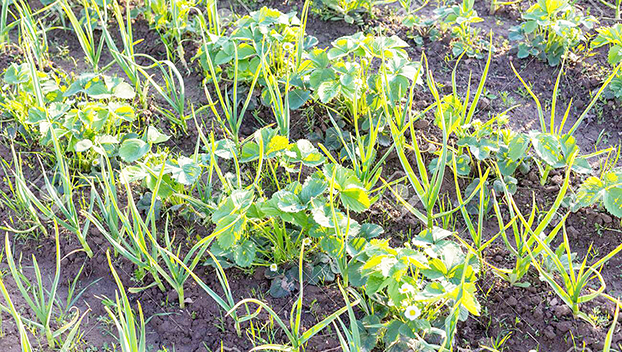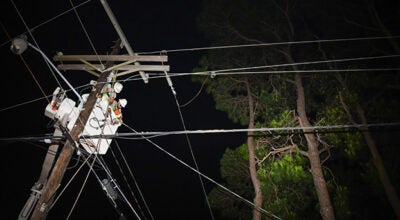EXPERT GARDEN TIPS — Friendly companions with Garlic and Strawberries
Published 12:08 am Wednesday, August 23, 2023

- Interplanting crops is a great way to make use of limited space in raised beds. Garlic interplanted with strawberries utilizes the herb’s pungent aroma that is a natural pest and fungi deterrent. (Photo courtesy of 123RF.com)
|
Getting your Trinity Audio player ready...
|
Interplanting crops is a great way to make use of limited space. Last week we discussed cultivating garlic (allium sativum) varieties that grow well in our area. Let’s expand our discussion of last week’s topic to include garlic companion planting by interplanting garlic with strawberries.
Garlic interplanted with strawberries utilizes the herbs pungent aroma as a natural pest and fungi deterrent. Some of you might not consider companion planting strawberries with garlic since many gardener’s plant strawberries in spring. But is spring the best season to plant strawberries in Southeast Texas?
The short answer is-it depends on how you cultivate strawberry plants Do you cultivate them as an annual or a perennial? This gardener grows them as an annual plant, which is why I interplant strawberries and garlic!
Our current weather conditions may be indicative of future patterns for Southeast Texas. This will have dramatic meaning for each of us since the “summer” season appears to be migrating from simply “hot & dry” for a short time frame to “arid & parched” for a lengthy time interval, as evidenced by too many daytime temperatures exceeding triple digits.
If we cultivate strawberries as annuals, rather than perennials we might be able to ‘work around’ SETX blistering summers.
Strawberries (Fragaria ananassa) rapidly fade to quickly becoming ‘crispy’ stems which are unable to survive our incredibly lengthy summers. Conversely, fall and winter’s balmy weather is an exceptional opportunity for gardeners to grow strawberries. Fall planting offers gardeners the prospect of a crop of strawberries much earlier than gardeners in most other areas of the country.
Annual vs. Perennial
Strawberries are hardy perennials in USDA hardiness zones five to eight, meaning they can survive many growing seasons. However, in USDA zones nine and greater, strawberries are grown as cool-season annuals, which means they are planted during fall, produce fruit in spring, removed in summer, and replaced with new plants the following fall.
In the southeast, it is best to plant strawberries in late October through mid-December (this is when I plant garlic) but keep a row cover (or two) handy, in case newly planted strawberries need protection from strong winds or cold temperatures.
Strawberries fall into two fruit-bearing categories: June-bearing and ever-bearing. June-bearing cultivars primarily develop flowers in the early spring from buds developed during the previous fall or under short-day conditions.
Ever-bearing usually produces fruit under long-day conditions. Ever-bearing do not perform well in our locale. Strawberry varieties which grow best in Southeast Texas: Chandler, Douglas, and Sequoia (my personal favorite). Anticipate each strawberry plant to produce up to one quart of strawberries within a 3-to-4-week period. Be prepared for your harvest.
Preparation & Planting
Vegetable gardens and raised beds require amendments for crop interplanting. Soil preparation is the key for successful interplanting strategies to work effectively.
For example, garlic is known to be a heavy feeder, to minimize competition for soil nutrients, amend garden soil thoroughly with an abundant amount of compost, especially where the garlic cloves are to be planted.
Strawberries require full sun and well-drained, neutral to slightly acidic soil, preferring a soil pH between 6.5 and 7. Space rows 12 inches apart, and individual plants 12 inches apart within the rows.
Soak the roots in water for an hour, then trim to 6 inches in length. Spread the roots and cover completely with soil, taking care not to plant the crown.
Once planted, interplant strawberries with garlic cloves, four to six inches away from each strawberry plant. Another way to interplant garlic is in a central row, spacing cloves three to four inches apart, one to two inches deep, then plant strawberries five to six inches from center on either side of the row.
Fertilize, Water & Mulch
Strawberries enjoy 5-10-10 fertilizer at planting time. Incorporate two cups fertilizer into the soil for each 10-foot planted row. Side dress plants with fertilizer every three weeks during the spring growing season.
Strawberries are shallow rooted, avoid allowing the roots to dry out. They perform best when provided uniform irrigation.
Strawberry plants require daily watering for the initial two weeks after planting to encourage root growth, then reduce watering frequency, but ensure the soil remains consistently moist.
Strawberries need to be mulched immediately after planting to reduce weeds and maintain soil moisture. Pine straw is by far the better mulch to use, using a 2-to-3-inch layer around each plant, while also covering planted garlic. Remove weeds during fall and winter months, reducing competition for soil nutrients.
Pests
We are not the only animals who enjoy the taste of strawberries! There are many animals and insects which devour strawberries, especially during the night.
Birds, squirrels, spider mites, slugs, snails and grubs are major pests of strawberries. Monitor the strawberry plants regularly, check for disease, insects, or other problems.
Leaf spots and grey mold are unfortunately, common diseases of strawberries. Be warned, slugs and snails wreak havoc on strawberry plants overnight, especially fruit. Be prepared to defend your prize strawberries! Have readily available a commercial ‘slug’ bait,’ that is safe to use around pets and wildlife without harming the environment. Garlic is a natural deterrent and will address some of these pests naturally.
So long for now fellow gardeners, let’s go out and grow ourselves a greener, more sustainable world, one plant at a time!
Comments and questions for John Green, Texas Certified master gardener, can be emailed to jongreene57gmail.com.





